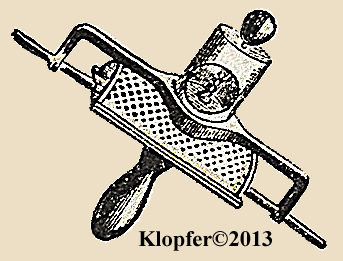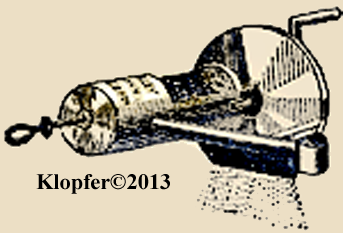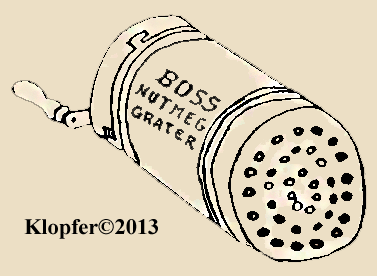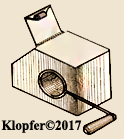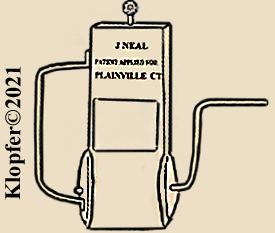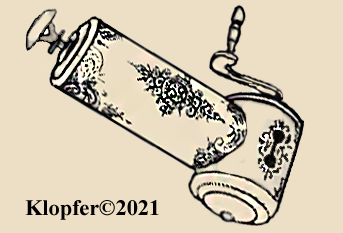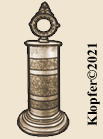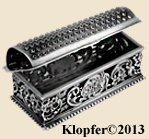
Click Me!
NutmegGraters.Com

- Home
- Featured Stories
- Picture Gallery
- Info.Wanted :
- Spurious Marks
- Trading Post
- Contact Our Site
- Wanted To Buy
[WELCOME: My articles published on NutmegGraters.Com and commercially (elsewhere) required many years of primary research, personal expense, travel and much effort to publish. This is provided for your enjoyment, it is required that if quoting my copyrighted text material, directly provide professionally appropriate references to me. Images are unavailable for copy. Thank you J. Klopfer.]
_______________________________________________________________________________________________________________________________________________________
The Regency Double-Lidded Bowl With Side Handle Table Nutmeg Grater ~ Attributed To Wise Tunbridge Ware Manufactory, Tonbridge, England
 The English Regency Period dates from 1811 to 1830. This name is derived from the appointed title Prince Regent assigned to George Augustus Frederick, who intervened as ruler of the British Empire (1811~1820) when his father the king became unable to rule due to a disabling mental illness. Following the kings death in 1820, George Augustus Frederick ascends to the throne as king George IV, and ruled until his death in 1830. A wildly extravagant man, George IV benefactored the evolving and distinctive styles and designs in architecture, art and fashion that are known today as the Regency Style (1811~1830).
The English Regency Period dates from 1811 to 1830. This name is derived from the appointed title Prince Regent assigned to George Augustus Frederick, who intervened as ruler of the British Empire (1811~1820) when his father the king became unable to rule due to a disabling mental illness. Following the kings death in 1820, George Augustus Frederick ascends to the throne as king George IV, and ruled until his death in 1830. A wildly extravagant man, George IV benefactored the evolving and distinctive styles and designs in architecture, art and fashion that are known today as the Regency Style (1811~1830).
One Regency table ~ kitchen nutmeg grater was styled as a double-lidded bowl with side handle. Too large to carry in one's pocket, these were created for use at the table or bar when flavoring alcoholic beverages. A rare silver example in this form bears London hallmarks for the year 1815/16; thus serving to identify a specific production period for this style [ SEE: Robert and Meredith Green Collection of Silver Nutmeg Graters, John D. Davis, Colonial Williamsburg Foundation/University Press of New England, pgs 38-9, 2002 ]. This form, however, was more commonly produced in simple treen turnery ware, or as painted Tunbridge Ware.
A plain treen example (Fig A1~A5) is constructed from medium brown woods; the bottom lid being lignum vitae (Fig A2), with the top cover and main body with its handle (Figs A2, A3 & A4) resembling boxwood, or cherrywood. Both the footed bottom and domed top covers are exquisitely threaded to screw with precision to the main body. A simple embellishment to the body is the turned indentation at its base (Fig A3) which transitions the bowl to the footed lid.
The tinned, non-detachable grater is dome shaped and machine stamped to meticulously fit into the body; both technologies developed after the turn of the nineteenth century. Inspection of more than a dozen nutmeg graters in this style, to include those constructed using other variations in wood and/or applied decorations, reveal all examples to have identical tinned graters. All are uniform in size and perforation patterns, each grater being punched out using the same equipment. All are punched into 16 rows by 16 rows of teeth, with center rows having 16 teeth tapering to edge rows containing a span of 6 teeth (Fig A6, Fig B2, Fig C2).

No identifying features or maker's marks are present, but several identical examples are known, an indication that it was a regularly manufactured item. Supported with other anecdotal evidence, these nutmeg graters are probably the creation of the Wise's Tunbridge Ware Manufactory, in Tonbridge, Kent, England. In that different manufacturers created similar products, further evidence is required to confirm this with certainty.
 Snapshots: Two Painted and Printed Tunbridge Ware Regency Table Nutmeg Graters:
Snapshots: Two Painted and Printed Tunbridge Ware Regency Table Nutmeg Graters:
As early as the mid-eighteenth century, Britain's wood turners decorated their woodenware products using printed paper labels. After 1800, topographical prints came into vague, featuring views of famous destination in Tunbridge Wells, Tonbridge, Brighton, Margate, Broadstairs, and elsewhere. Decorated with painted pin stripes and prints, whitewood wares of holly, beech, chestnut and sycamore were most popular starting about 1810, but declined by 1835. The woodworking firm, Wise Tunbridge Ware Manufactory, Tonbridge, England created these print labels for use on their products as well as selling them to other turners. Many Wise prints are well documented; such as shown below (Fig B1 & Fig C1).
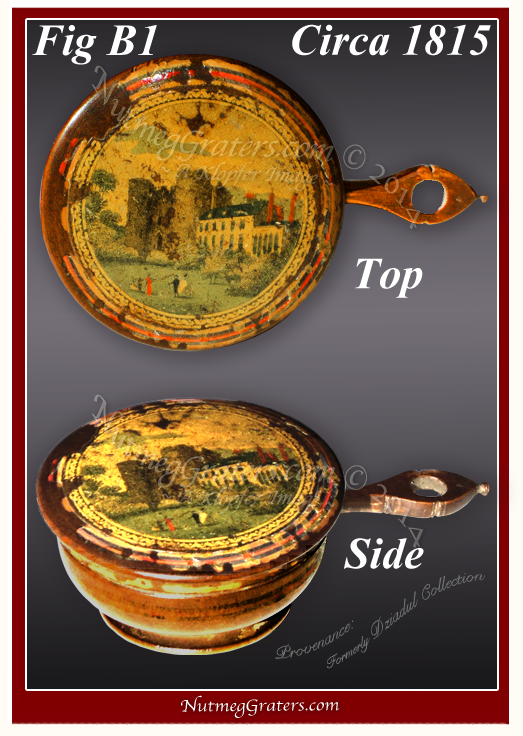
Tonbridge Castle (A Wise Print):
Tonbridge Castle is located in Tonbridge, Kent, England. It was first built in 1088, rebuilt in 1253, and the mansion added in 1793. Following discovery of Kent's bathing springs in the early sixteen hundreds, for centuries, England's gentry arrived as spa patrons and tourists to Tonbridge and Tunbridge Wells, where treenware mementos were in demand.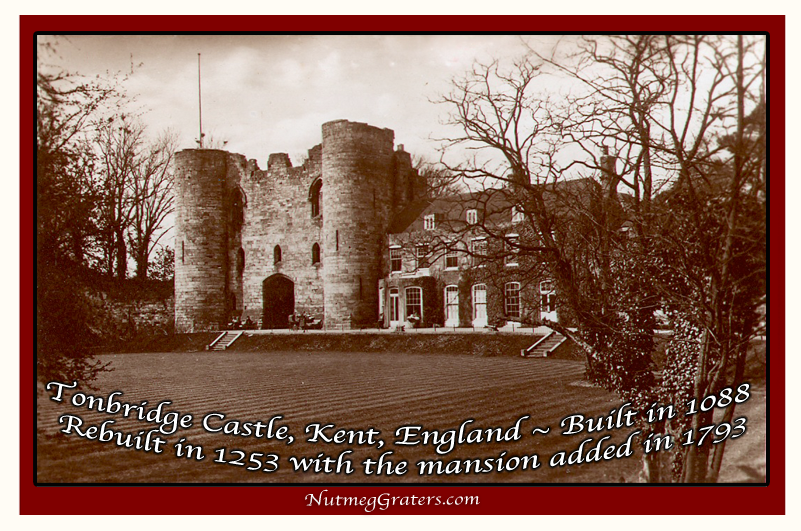
This second Regency bowl style table nutmeg grater (Fig B1) retains its Wise print, depicting both the castle and the mansion. In the print's foreground, people are dressed in Regency style clothing. What remains of black and red striping, surrounds the bowl and the entire piece is constructed throughout using a medium brown wood. This item probably dates similarly to the above sited silver example, being fabricated Circa 1815.
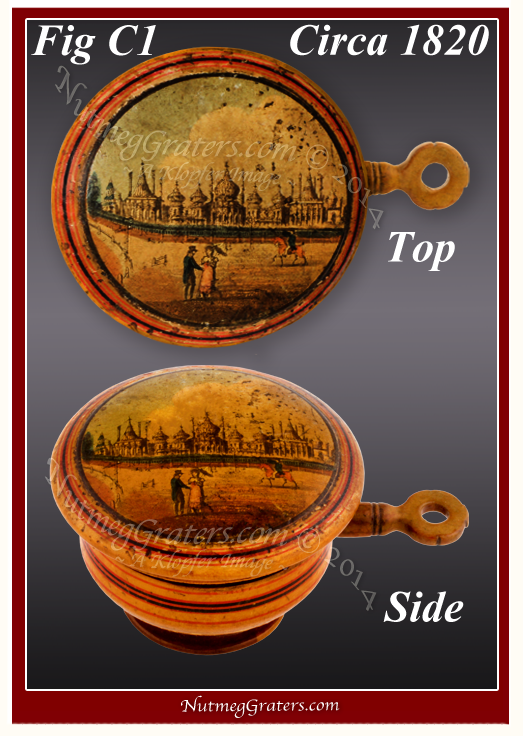 Brighton Palace Royal Pavilion (A Wise Print):
Brighton Palace Royal Pavilion (A Wise Print):
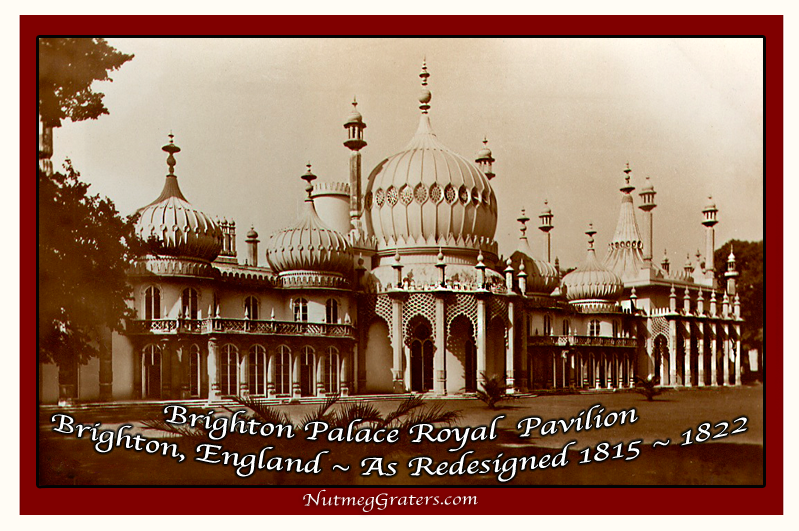 Located in East Sussex, England, the Brighton Palace, sometimes known as the Royal Pavilion, was built in three stages between 1787 to 1822. Its owner, Prince Regent George Augustus Frederick purchased land adjacent to the palace, where he commissioned his spectacular and immense glass domed riding school and stables built from 1803 to 1808, in the romantic Indo-Saracenic style. Following this, designed by the famous architect John Nash, the palace was rebuilt between 1815 to 1822 in the same whimsical Indo-Saracenic style. The Royal Pavilion was revered by the fashionable Regency gentry of its time, and remains a celebrated and distinctive modern landmark.
Located in East Sussex, England, the Brighton Palace, sometimes known as the Royal Pavilion, was built in three stages between 1787 to 1822. Its owner, Prince Regent George Augustus Frederick purchased land adjacent to the palace, where he commissioned his spectacular and immense glass domed riding school and stables built from 1803 to 1808, in the romantic Indo-Saracenic style. Following this, designed by the famous architect John Nash, the palace was rebuilt between 1815 to 1822 in the same whimsical Indo-Saracenic style. The Royal Pavilion was revered by the fashionable Regency gentry of its time, and remains a celebrated and distinctive modern landmark.
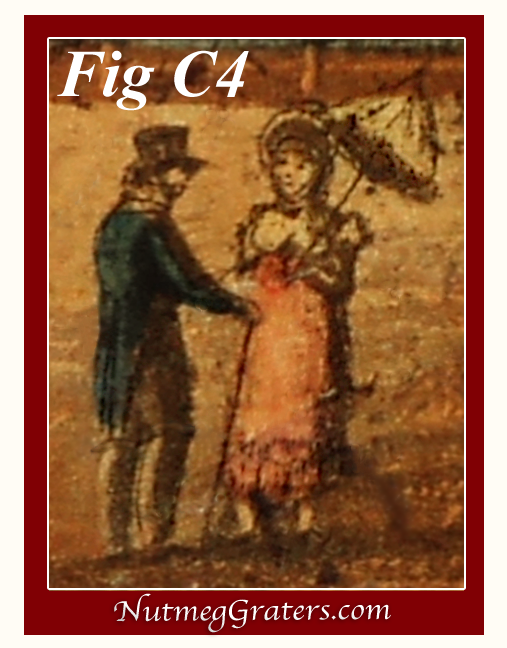
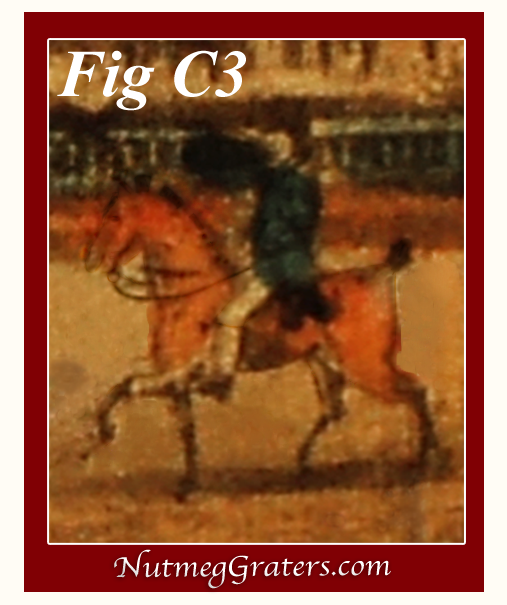 A third Regency bowl style table nutmeg grater (Fig C1) features a Wise print of Brighton Palace combined with its riding school's steeple chase and a horse racing circuit. Off center, a horseman trots his thoroughbred (Fig C3). The horse's tail is docked (cut short) and nicked (when stabled, the tail is placed in an upright stanchion so that the tail is trained to stand upright) ~ methods used with high quality show horses. In the foreground, a fashionably dressed couple help us to establish the production date for this nutmeg grater (Fig C4). Although the gentleman's tailcoat and buckskin riding breeches are typical attire of the privileged class seen throughout the Regency period, women's fashions changed annually. The lady wears a high style walking dress having the short waisted gown falling directly under her bosoms with the lower skirt extremity in ruffled banding (styles dating between 1816~1819) and a big brimmed bonnet with a ribboned chin strap and contrasting ruche lining inside the brim (styles dating 1817 & 1818). [NOTE: Ruche: a pleated, fluted or gathered strip of fabric used for trimming.] Popularized from French fashion of this period, the lady carries a parasol constructed from sheer fabrics, serving as sunshade rather than against inclement weather. [NOTE: Parasol: para- 'protecting against' & sol- 'sun'.] Based on this evidence, this Regency nutmeg grater dates to Circa 1820.
A third Regency bowl style table nutmeg grater (Fig C1) features a Wise print of Brighton Palace combined with its riding school's steeple chase and a horse racing circuit. Off center, a horseman trots his thoroughbred (Fig C3). The horse's tail is docked (cut short) and nicked (when stabled, the tail is placed in an upright stanchion so that the tail is trained to stand upright) ~ methods used with high quality show horses. In the foreground, a fashionably dressed couple help us to establish the production date for this nutmeg grater (Fig C4). Although the gentleman's tailcoat and buckskin riding breeches are typical attire of the privileged class seen throughout the Regency period, women's fashions changed annually. The lady wears a high style walking dress having the short waisted gown falling directly under her bosoms with the lower skirt extremity in ruffled banding (styles dating between 1816~1819) and a big brimmed bonnet with a ribboned chin strap and contrasting ruche lining inside the brim (styles dating 1817 & 1818). [NOTE: Ruche: a pleated, fluted or gathered strip of fabric used for trimming.] Popularized from French fashion of this period, the lady carries a parasol constructed from sheer fabrics, serving as sunshade rather than against inclement weather. [NOTE: Parasol: para- 'protecting against' & sol- 'sun'.] Based on this evidence, this Regency nutmeg grater dates to Circa 1820.
Regency bowl style table nutmeg graters are moderately rare. [KLOPFER article © January 2014]
